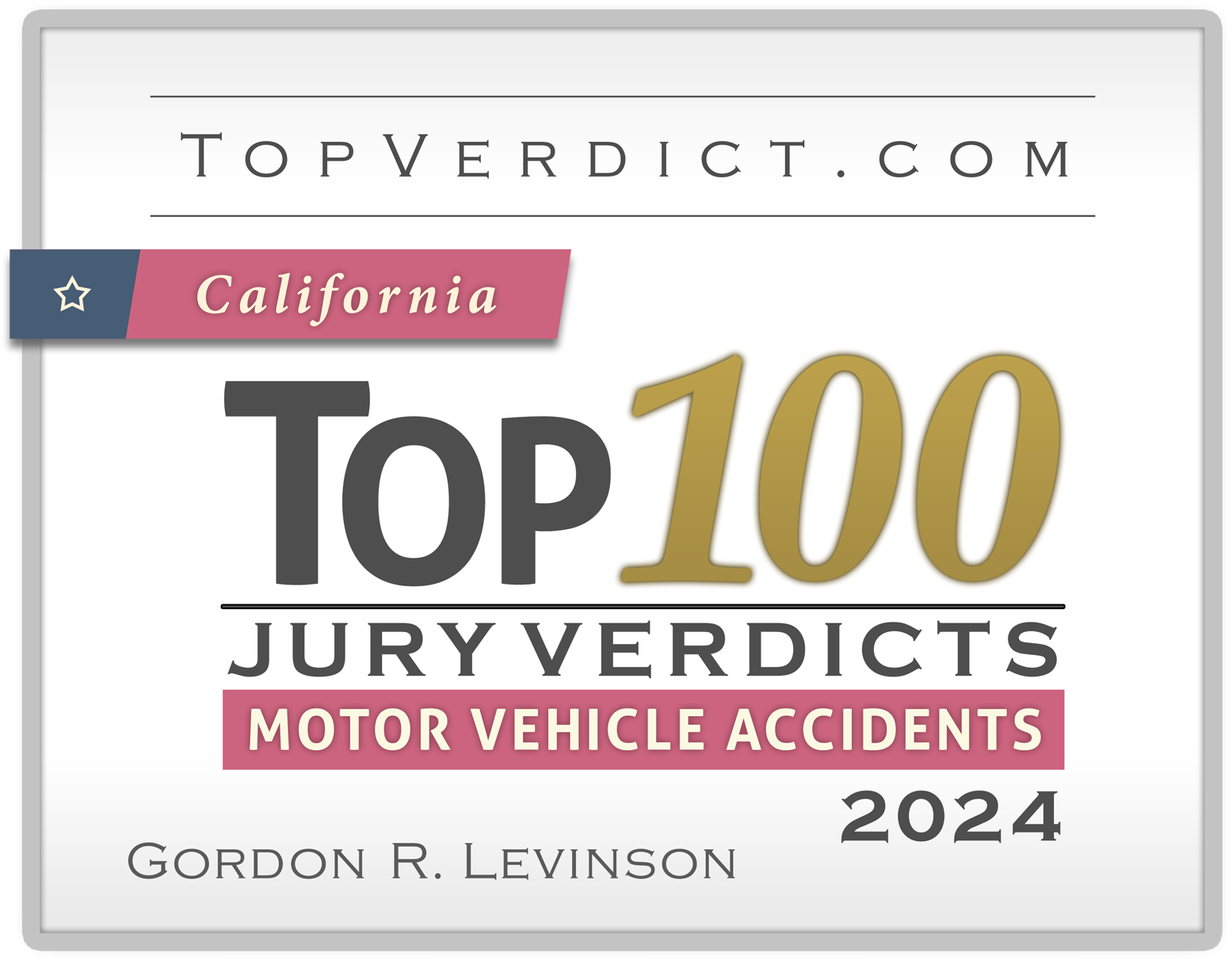Were You or a Loved One Injured By Someone Else’s Negligence?
Our San Diego Negligence Lawyers Are Here to Fight for You
When many people hear the word negligence, their minds immediately go to medical negligence and malpractice. While medical malpractice is a high-profile example of negligence, it is far from the only place that negligence can occur. Negligence is the legal foundation behind many of the most common personal injury claims that occur in everyday life. Whether someone is hurt in a car crash, suffers a dog bite, or slips and falls in a store due to unsafe conditions, negligence is often at the root of these accidents.
We Are The Levinson Law Group, San Diego Lawyers for Negligence Near You
We are a dedicated San Diego negligence law firm with extensive experience working with clients who have been seriously injured in motor vehicle accidents or on someone else’s property.
At Levinson Law Group, we help injury victims who were harmed because another person, company, or entity failed to act with reasonable care, resulting in negligence. Our team of experienced negligence lawyers in San Diego & Carlsbad represent people who are hurt through no fault of their own, those who deserve to be compensated for their injuries, their lost wages, and their pain and suffering.
What Is Negligence Under California Law?
Under California law, negligence occurs when someone fails to use reasonable care or fails to follow proper duty of care to prevent harm to others. Negligence is considered to be when a breach of the duty every person has to avoid causing foreseeable harm to others. To win a negligence case, a plaintiff must prove:
- The defendant owed a duty of care.
- The defendant breached that duty.
- That breach directly caused the injury.
- The plaintiff suffered measurable damages.
In California, the concept of comparative negligence may also apply to negligence cases. This means that even if a victim was partially at fault, they can still recover compensation, though their compensation award may be reduced based on their share of fault. Our lawyers for negligence in San Diego can walk clients through this complex system and ensure they aren’t unfairly blamed for an accident that wasn’t their fault.
Types of Negligence Cases We Handle
Negligence plays a role in nearly every personal injury case or insurance accident claim. If someone failed to act with the level of care that a reasonably prudent person would have in the same situation, and their actions caused harm, that’s negligence. Below are the types of cases our San Diego negligence lawyers handle:
Car Accidents
Car accidents are one of the most common examples of when negligence can occur. Whether it’s distracted driving, speeding, failing to yield, or driving under the influence, negligent drivers endanger everyone on the road. We work to hold reckless motorists accountable and pursue full compensation for our clients.
Uber & Lyft Accidents
When rideshare drivers fail to follow traffic laws or drive distractedly, they put passengers, pedestrians, and other motorists at risk. Whether you’re a rider or another driver or passenger that was injured in a rideshare crash, our team of negligence lawyers in San Diego can help you sue for negligence and seek damages under Uber or Lyft’s insurance policies.
Truck and Commercial Vehicle Accidents
Truck drivers and commercial vehicle operators are held to higher standards due to the size and danger of their vehicles. Negligence can be seen in the form of:
- Driver fatigue
- Overloaded trailers
- Improperly maintained vehicles
At Levinson Law Group, our lawyers for negligence handle claims against drivers, companies, and even third-party contractors.
Motorcycle & Bicycle Accidents
Motorcyclists and bicyclists are vulnerable on San Diego roads, especially in the heavily trafficked areas. Unfortunately, negligent drivers often fail to see or respect them. Our negligence lawyers in San Diego help injured riders recover damages when their crashes are caused by driver inattention, unsafe lane changes, or failure to yield.
Pedestrian Accidents
A driver who fails to yield at a crosswalk or ignores traffic signals may be found negligent if a pedestrian is struck. Pedestrian accident injuries are often severe and require immediate legal action to protect the victim’s rights.
Slip & Fall Injuries
Property owners in San Diego, have a duty to maintain a safe premises. When certain conditions cause someone to slip and fall, it may be grounds for the victim to sue for negligence. This can include:
- Wet floors
- Broken railings
- Poor lighting
- Other hazards cause someone to fall
We handle premises liability claims against homeowners, landlords, businesses, and municipalities whose negligence has cause injury to a citizen.
Dog Bites
California laws hold dog owners strictly liable for dog bites, but negligence on the owner’s behalf still plays a role. This is especially true when owners fail to leash or control their animals in public areas. A negligence lawyer from our team will work closely with you to fight for your right to compensation for the dog bite, especially when the victims are children or the elderly.
Brain Injuries
From car accidents to slip and falls, traumatic brain injuries (TBIs) can change a person’s life forever. When these injuries are caused by negligent acts, such as speeding, not cleaning up a puddle in the store, or allowing an aggressive dog to be off leash, our team works to build strong claims supported by medical experts, life care planners, and economists.
Boat Accidents
Recreational boating is a very popular pastime in San Diego, but negligent actions from boaters on the water can be deadly. Speeding, operating their vessel under the influence, and poor vessel maintenance are all forms of negligence that can lead to injury or even death. We represent victims of jet ski collisions, private boat crashes, and tourist boat accidents so that they can obtain the compensation they deserve.
Construction and Farm Vehicle Accidents
Injuries involving tractors, forklifts, bulldozers, and other heavy equipment, especially while on the clock, are often the result of negligence on job sites or public roads. If safety protocols are ignored or machinery is operated recklessly, our team is prepared to sue for negligence and seek full compensation for injured parties.
Injuries on Military Bases (Including Camp Pendleton)
Our team of lawyers for negligence is experienced in handling injury claims that occur on or around military bases, including Camp Pendleton. While these types of cases involve unique legal rules, especially when federal property is involved, we are prepared to manage them on behalf of civilians and military families.
Public Transportation Accidents
Bus drivers, operators, and city transit authorities can all be found negligent when certain conditions are met that cause a crash or injury. Whether the issue was mechanical failure, driver fatigue, improper maintenance, or unsafe stops, we handle bus accident claims against city and county transit systems.
Injuries at Theme Parks, Swimming Pools, and Sporting Events
Entertainment venues owe visitors a duty of care to provide a safe environment. When rides malfunction, pools are left unsupervised, or crowds are negligently managed, serious injuries and death can occur. We help injured guests sue for negligence when amusement parks, stadiums, or event staff fail to keep their premises safe.
- Sea World: 500 Sea World Dr., San Diego, CA 92109
- San Diego Zoo: 2920 Zoo Drive, San Diego, CA 92101
- Belmont Park: 3146 Mission Blvd, San Diego, CA 92109
Senior Citizen Injuries
Elderly individuals are especially susceptible to injuries when accidents occur. Our team at Levinson Law Group handles claims involving senior injuries due to falls, unsafe conditions in public places, and transportation accidents. Property owners and caretakers who neglect their duty of care can and should be held accountable and provide compensation to victims.
Wrongful Death
When negligence causes someone to lose their life, the family may be able to pursue a wrongful death claim to seek justice. These are some of the most emotionally charged cases our lawyers for negligence handle, and we work with care and compassion to pursue justice for grieving families.
Recent Settlement: Bowling Alley Patron Sues for Negligence
The Levinson Law Group recently secured a $365,000 settlement for a client who suffered a broken leg in a slip and fall accident at a local bowling alley. Despite the insurance company initially offering nothing, the firm aggressively pursued the claim and negotiated a significant recovery without the need for surgery. This outcome highlights the firm’s commitment to fighting for injured clients, even when the other side refuses to take responsibility.
Speak With a San Diego Negligence Lawyer Near You Today
Negligence can cause many different types of accidents, but all too often, they lead to life-altering injuries. If you or a loved one was hurt due to someone else’s careless actions, you may have legal options for pursuing negligence.
Our San Diego team of negligence lawyers is here to help you pursue justice. From car accidents and bicycle crashes to slip and falls and construction site injuries, we’re committed to holding negligent parties accountable.
Put our knowledge, experience, and strategic insight to work for you. Call today at (619) 436-5000 for your free consultation.







